Dr. Justine Lee discusses Halloween pet dangers. For more from Dr. Lee, find her on Facebook or at www.drjustinelee.com!
Ah, Halloween, one of the busiest chocolate holidays of the year!
As Halloween night approaches, keep in mind that some human treats can be potentially deadly for your dog or cat. Help keep your dog and cat safe by being aware of some of the common poisons found in your child’s trick-or-treat bag this year.
1. Chocolate
If your dog likes to sneak in one or two chocolate mini-bars, it likely won’t cause a problem (as there’s very little “real” chocolate in candy). However, during this fall holiday, dogs have a tendency to gorge and eat a massive amount of chocolate candy all at once. Keep your candy jar and your kid’s Halloween stash away from food-motivated dogs (e.g., Labrador retrievers, mixed-breed dogs). When it comes to chocolate, the ingredient methylxanthine (e.g., theobromine, caffeine) can be poisonous to your dog. (Thankfully, cats rarely develop chocolate poisoning, as they rarely gorge on more than 1-2 pieces.) Mild ingestions typically result in agitation, vomiting, diarrhea and excessive panting. Larger amounts can result in heart-toxicity: abnormal heart arrhythmias (abnormal rhythm), an elevated heart rate, and a very high blood pressure. Massive amounts can result in neurologic signs like tremoring, seizuring, or rarely, death. When it comes to chocolate, keep in mind that the darker and more bitter the chocolate (e.g, Baker’s chocolate, dark chocolate), the more poisonous it is to your dog. Click here to learn more about chocolate toxicity.
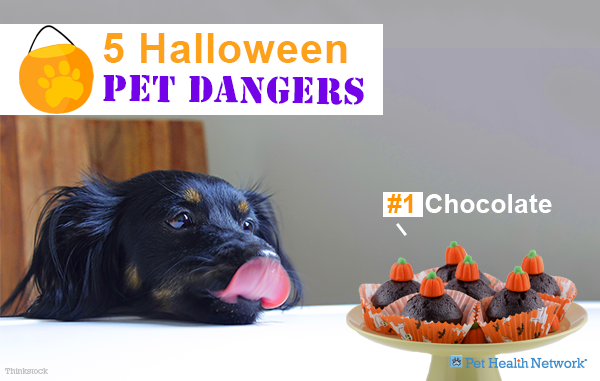
2. Sugarless Sweets
Another danger in your kid’s Halloween stash is sugar-free candy (Who tortures kids by giving this away, anyway?!). Xylitol, a natural sugar-free sweetener, can result in low blood sugar (hypoglycemia) and even liver damage (e.g., acute hepatic necrosis) when ingested by dogs. Certain candies, mints, baked goods, and gums can contain large amounts, resulting in xylitol poisoning. Clinical signs of weakness, vomiting, lethargy, collapse, a racing heart rate, and generalized malaise can be seen. When xylitol is ingested in doses > 0.5 g/kg, clinical signs of jaundice (e.g., yellowing of the skin), vomiting, black-tarry stool, anorexia, and liver failure can be seen. Click here to learn more about xylitol poisoning.
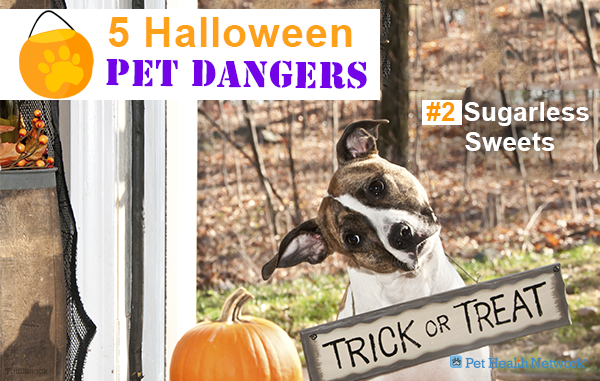
3. Raisins
Once in a while, you’ll have a healthy neighbor who gives away small boxes of raisins during Halloween (Boo). Raisins, grapes, and certain currants (anything in the Vitus spp.) can cause acute kidney injury when accidentally ingested by dogs. Clinical signs may not show up for days, after severe damage to the kidneys has already occurred. Signs such as inappetance, vomiting, belly pain, halitosis (bad breath), excessive or decreased thirst or urination, generalized malaise, and increased kidney values (e.g, creatinine, BUN) may be seen. Click here for a video about chocolate, raisin and grape dangers.
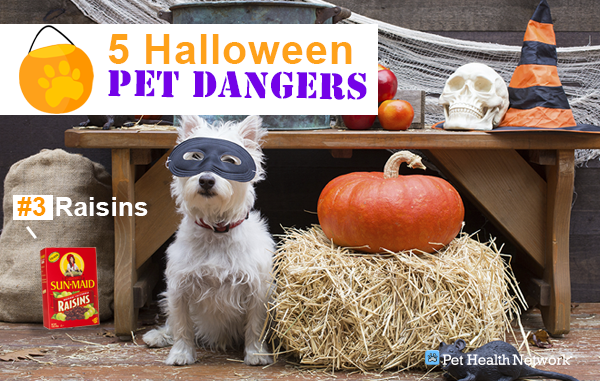
4. Liquid Potpourri
This is one big danger to our feline friends! As fall commences, pet owners often may use simmer potpourri pots to instill scents of pumpkin and cinnamon around the house. When the liquid potpourri is ingested by cats (after all, curiosity killed the cat!), the essential oil may cause corrosive burns to the mouth. Clinical signs of drooling, mouth pain, anorexia, pawing at the mouth, difficulty breathing, and malaise may be seen. Rarely, liver failure and lung failure can occur.
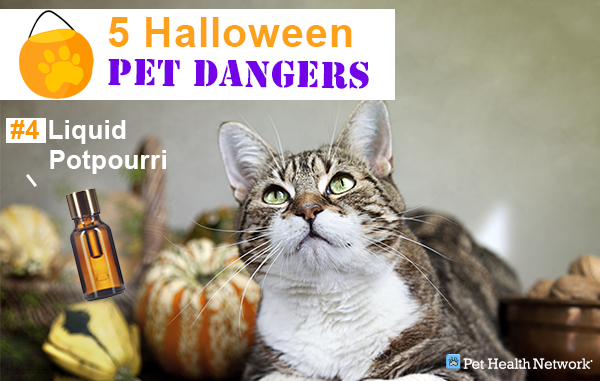
5. Glow Sticks/Jewelry
If you use glow sticks to put on your child’s costume during Halloween, heed caution. While this glowing jewelry may add extra light into your child’s life, it’s poisonous to cats. Cats seem to love to chew on these toys, and accidentally ingest the chemical within. While it’s not very poisonous, this chemical has a very bitter taste, resulting in profuse drooling, oral pain, inappetance, and vomiting. If you think your cat chewed into one, turn off the light, look for the presence of the glowing liquid, and then remove the chemical carefully from your cat. This can be done by:
A) Flushing the taste out of the mouth (offering something tasty like chicken broth or milk)
B) Bathing your cat with a liquid dish soap to get the remaining liquid off the fur. As cats are fastidious groomers, they may expose themselves to more of the bitter chemical if it’s still on their fur.
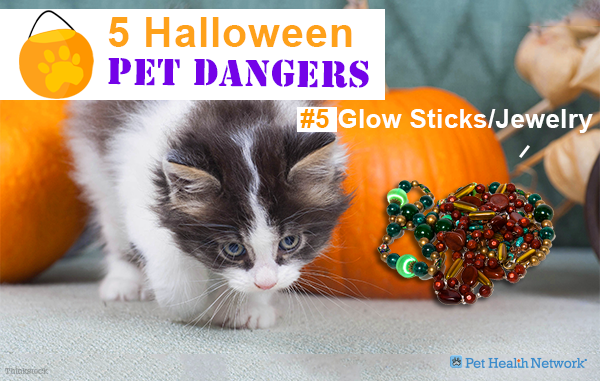
Keep your pet safe this Halloween. Rather than spend the night in the emergency room with your pet, pet-proof all these items away instead!
If your dog or cat did get into something poisonous, make sure to contact your veterinarian or an animal poison control immediately for life-saving care.
When in doubt, if you think your pet was poisoned, call your veterinarian, emergency veterinarian, or the ASPCA Animal Poison Control Center for life-saving care.
If you have any questions or concerns, you should always visit or call your veterinarian – they are your best resource to ensure the health and well-being of your pets.
